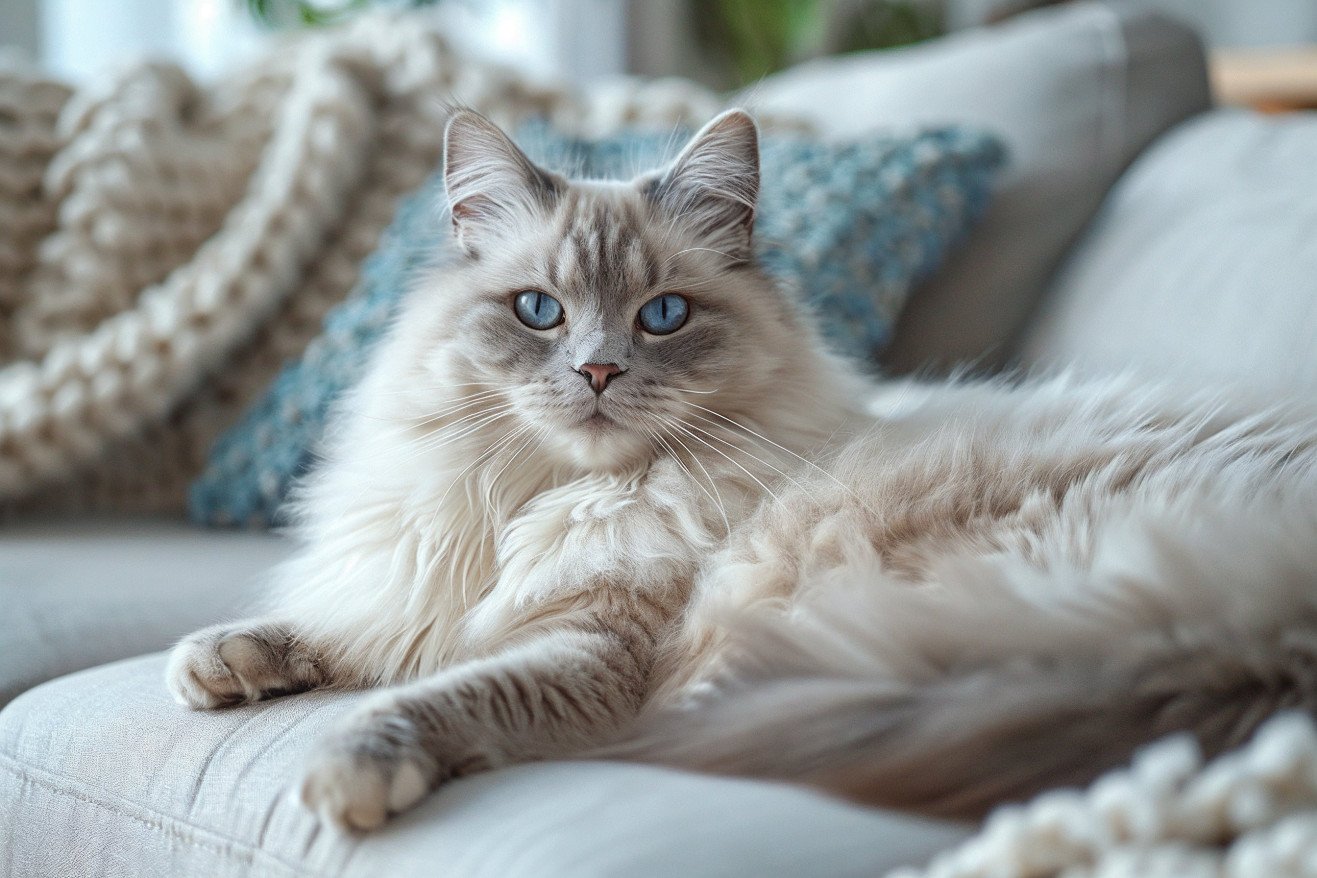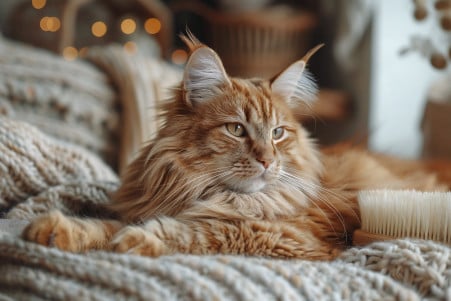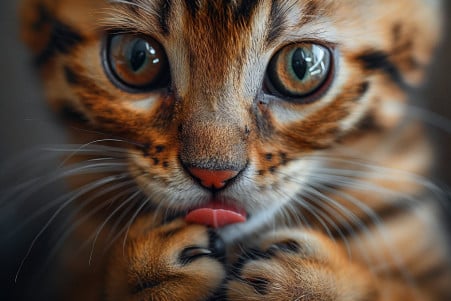Do Ragdoll Cats Shed? What to Expect and How to Groom
27 May 2024 • Updated 27 May 2024

If you're thinking about adopting a ragdoll cat but are concerned about the amount of hair they'll leave around your house, you're not alone. Ragdolls are a medium-shedding cat breed, and their shedding will increase during the spring and fall, but regular grooming can help keep shedding in check.
While no cat is completely hypoallergenic, we'll take a look at the things that affect how much ragdoll cats shed and what their grooming needs are. We referenced expert veterinary and people who have lived with ragdolls. With this information about their coat, how much they shed, and how to groom them, you can decide if a ragdoll's medium shedding is something you can live with in your home and manage with your lifestyle.
Do Ragdoll cats shed?
Things That Impact Ragdoll Cat Shedding
One of the biggest things that can impact shedding in Ragdoll cats is the change of seasons. As Exclusive Ragdolls explains, Ragdolls tend to shed the most in the spring and fall as they adjust to temperature changes. This is known as seasonal shedding.
Diet is another major factor in shedding. Reveal Pet Food explains, a diet that's high in protein and includes omega-3 and omega-6 fatty acids can help maintain a healthy coat and reduce shedding. On the other hand, a diet that's low in essential nutrients can negatively impact the skin and fur.
In addition to seasonal and dietary factors, there are several other things that can lead to increased shedding. As Splootvets points out, age, stress, allergies, and health issues like hyperthyroidism and diabetes can all cause cats to shed more than usual. Not grooming and caring for the coat properly can also lead to more mats and shedding.
Knowing these factors that impact Ragdoll cat shedding can help cat owners be more proactive in managing their cat's shedding and keeping their cat's coat looking and feeling great. Making sure to feed a diet that's well-balanced and high in protein, reducing stress, addressing health issues, and keeping up with grooming are all important ways to manage shedding.
Must-Have Brushes for Ragdoll Cats
According to Freshly Bailey, dual-length metal combs are the best brushes for detangling and dematting Ragdoll coats. These combs are Ragdoll-specific and feature short and long teeth to help cut grooming time in half. The rounded head pins are designed to massage the skin while protecting it from irritation.
Freshly Bailey also recommends dematting brushes with short strokes to get rid of tough mats and tangles. These brushes are great for reaching the undercoat and working through hard-to-reach tangles, but they should be used carefully to avoid hurting the cat.
For everyday grooming, self-cleaning slicker brushes are the easiest to use and maintain, according to Catster. These brushes are user-friendly, thanks to features like retractable bristles and a soft grip handle, and can help ensure a positive grooming experience.
Deshedding tools like shedding blades and rakes can also be helpful for Ragdoll cats, especially when it comes to removing loose fur and reducing shedding, says Floppycats. Like other grooming tools, the earlier these are introduced, the more likely they are to be accepted by Ragdolls.
By using the right brushes and taking a gentle approach, Ragdoll cat owners can stay on top of their cat's grooming needs and reduce the amount of shedding that occurs in their homes.
How to Groom a Ragdoll Cat
Ragdolls need to be brushed at least twice a week with the hair growth, using a soft brush and avoiding any pulling or tugging of the hair, according to Pastel Ragdolls. In fact, ABK Grooming says that Ragdolls love to be groomed and will often show their appreciation with purring and headbutts.
Grooming sessions should be introduced gradually and kept positive for the cat. Untamed suggests brushing or combing your Ragdoll once or twice a week, which will help you keep an eye on their health and give you some quality bonding time. Make sure to focus on areas that are more prone to matting, like behind the ears and under the tail.
If the cat is being groomed regularly, it's unlikely that they'll need to be bathed, according to Pastel Ragdolls. However, if the coat is dirty or greasy, it may be time for a bath to prevent issues like hair follicle infections. By following these grooming tips, Ragdoll owners can keep their cat's coat looking and feeling great.
How to Deal With Seasonal Shedding in Ragdoll Cats
Ragdoll cats are known for having a more pronounced shedding period in the spring and fall when they are adjusting to the change in seasons, a process called seasonal shedding. Exclusive Ragdolls explains that this can lead to an increase in shedding that is a common complaint among Ragdoll cat owners.
To deal with this seasonal shedding, cat owners should be prepared to brush their Ragdoll cats more often during the spring and fall, ideally every day or every other day. Exclusive Ragdolls explains that this will help remove the excess fur and keep the hair in the house to a minimum.
In addition to more frequent brushing, deshedding tools such as shedding blades and rakes can be helpful in getting rid of the extra fur that comes with seasonal shedding, as Floppycats points out. For more extreme cases of seasonal shedding, cat owners may want to consider professional grooming or even shaving, as advised by users on the City-Data Forum.
Feeding a cat a high-protein diet and making sure they are well-hydrated can also help improve the health of their coat and reduce shedding, according to Reveal Pet Food. By using a combination of more frequent grooming, deshedding tools, and proper nutrition to combat seasonal shedding, Ragdoll cat owners can keep their cat’s coat in check and keep the amount of hair in their home to a minimum.
Debunking Myths and Common Questions
Despite the claims of many breeders and pet websites, Ragdoll cats are not hypoallergenic. According to Floppycats, Ragdolls are not hypoallergenic and do shed, although they may produce less dander than other breeds.
In addition to normal shedding, excessive shedding in Ragdoll cats may be a sign of an underlying health problem that needs to be addressed by a veterinarian, say the veterinarians at Sploot. Allergies, stress, age, and hyperthyroidism are just a few examples of things that can cause increased hair loss in cats.
Even if they are indoor cats, Ragdolls need regular grooming. According to Pastel Ragdolls, Ragdolls should be brushed at least twice a week to help control shedding and ensure their coat remains healthy and free of mats.
While shaving Ragdolls is generally safe when it's done by a professional groomer, it should be done with caution. Users on the City-Data Forum note that a "lion cut" can be helpful for Ragdolls that shed excessively in the summer.
By using the right grooming products and techniques and staying on top of their cat's coat care, Ragdoll cat owners can keep shedding under control and reduce the amount of hair their cat leaves around the house. By knowing the truth about Ragdoll shedding, owners can enjoy their time with these loving pets.
Conclusion: Learning to Love Ragdoll Cat Shedding
Ragdoll cats are moderate shedders, but their coats are manageable with proper care. Regular grooming, a high-quality diet, and deshedding tools can minimize loose hair. Knowing when Ragdoll cats shed and what causes shedding can help you keep their coats healthy. With the right care, Ragdoll cats can be a great addition to your home.
Ragdolls are moderate shedders, but they do shed more during the spring and fall. Catster notes that Ragdolls have semi-long, plush coats that contribute to their higher-than-average shedding. This is due in part to their mixed-breed lineage, which includes Persian and Siamese cats.
Ragdolls need to be groomed regularly to keep their coats healthy and prevent matting. Catster explains that grooming should start at the head and go in the direction of the hair growth, with a comb used to work out any tangles. They also caution that Ragdolls can be sensitive to certain types of clippers, so it's important to find a groomer who is experienced in caring for the breed.
Catipilla recommends that Ragdolls be groomed at least twice a week to prevent tangles and skin issues. They also suggest using a soft-bristled brush to make the experience more pleasant for the cat.
While Ragdolls aren't completely hypoallergenic, Floppycats notes that they produce less dander than some other breeds, which can make them a better option for people with cat allergies. That said, they do shed a lot, and their owners will need to be prepared to deal with it.


